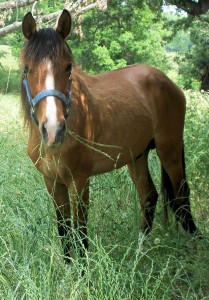An American Indian Horse shows these qualities…
- Usually carries Spanish Barb, Arabian, Mustang, or Foundation Appaloosa blood in his veins, even if you don’t know his pedigree.
- Shows the litheness, agility, endurance and load-carrying capabilities of the bloodlines shown above. Often very flexible, intelligent, independent and able to take care of themselves — still has the “wild” streak in them that allows them to respond well to danger. However, they are friendly and courageous, easily trusted around children and pets.
- DOES NOT SHOW small feet in comparison to the body structure, overly muscled/fat body style of the “modern” breeds, overly straight legs, overdefined conformation. Also does not have many of the digestive, nervous, and muscular problems associated with modern pampered breeds.
- May be of any color, often includes the rare colors such as lilac roan, peacock spotted leopard, or overano paint. Unusual markings such as lightning marks, leg striping, line-backing, or varnish marks are much more common in this breed due to the Spanish Barb influence. Colored Appaloosas of the foundation type are common, as are the various paints, pintos, and mixtures of colors.
- Normally a smaller, more compact animal of 15 hands or less, although larger and smaller sizes are common.
- Often has a lot of fetlock and body hair if allowed to grow out, to protect him from the elements. Hooves are hard and healthy.
- American Indian Horses are highly prepared by Mother Nature to survive hot summers in arid deserts, frigid winters, and sloppy conditions in between; on less feed and with less care than other horses. They can be ridden long distances with fewer injuries, perform heavy ranch and range work with more power, and generally provide better “horsepower” than horses much larger.
- You may have an American Indian Horse in YOUR barn. Activities such as shows, trail rides, and awards are provided through the Registry. You can double-register your ApHA, APHA, etc. horses, too if they meet the conformation, color, and pedigree requirements of the AIHR.
